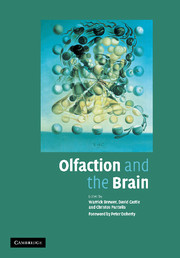Book contents
- Frontmatter
- Contents
- Foreword
- Preface
- List of Contributors
- Section I Neurology, Neurophysiology and Neuropsychology: Olfactory Clues to Brain Development and Disorder
- Section II Social Functioning: Role of Evolution, Genetics and Gender
- 8 Primate Olfaction: Anatomy and Evolution
- 9 Genetics and Family Influences on Olfaction: A Focus in Schizophrenia
- 10 Sex Differences and Olfactory Function
- 11 The Role of Pheromones and Chemistry: Lessons from Comparative Anatomy
- 12 The Impact of Olfaction on Human Social Functioning
- Section III Assessment and Disorders of Olfaction
- Index
- Plate section
- References
11 - The Role of Pheromones and Chemistry: Lessons from Comparative Anatomy
from Section II - Social Functioning: Role of Evolution, Genetics and Gender
Published online by Cambridge University Press: 17 August 2009
- Frontmatter
- Contents
- Foreword
- Preface
- List of Contributors
- Section I Neurology, Neurophysiology and Neuropsychology: Olfactory Clues to Brain Development and Disorder
- Section II Social Functioning: Role of Evolution, Genetics and Gender
- 8 Primate Olfaction: Anatomy and Evolution
- 9 Genetics and Family Influences on Olfaction: A Focus in Schizophrenia
- 10 Sex Differences and Olfactory Function
- 11 The Role of Pheromones and Chemistry: Lessons from Comparative Anatomy
- 12 The Impact of Olfaction on Human Social Functioning
- Section III Assessment and Disorders of Olfaction
- Index
- Plate section
- References
Summary
Introduction
The human sense of smell is as much a product of the evolutionary history of humankind as is every other physical characteristic of our species. Current perspectives view the sense of smell as evolved with the air-breathing, terrestrial vertebrates sometime in the Devonian, more than 300 million years ago. In its essential elements, it remains remarkably similar to that from which it evolved, and in physiological terms it is not much different from the common chemical sense found today in fish, aquatic and even terrestrial invertebrates. What is specific to an air-breathing life is the means whereby chemical molecules reach the olfactory mucosa. To achieve this, chemical molecules are swept into the nasal cavity where the inspired airstream is filtered and humidified. Part of the stream sweeps the molecules upwards and backwards and deposits them on the olfactory mucosa.
As discussed in more detail in Chapter 8, the physical nose and lateral conchae are relatively uncomplicated in humans, lacking the whorls and labyrinths formed by the convoluted filamentous scroll bones frequently found in mammals. The nostrils are simple, intact and directed downwards without the lateral flaps or even trumpet-like projections that often typify the nostrils of other mammals. Furthermore, the rhinarium – the patch of skin at the tip of the nose and surrounding the nostrils – is dry; a characteristic shared by humans only with the higher apes and a few non-primate species such as horses, moose and some desert antelopes.
Keywords
- Type
- Chapter
- Information
- Olfaction and the Brain , pp. 203 - 219Publisher: Cambridge University PressPrint publication year: 2006



